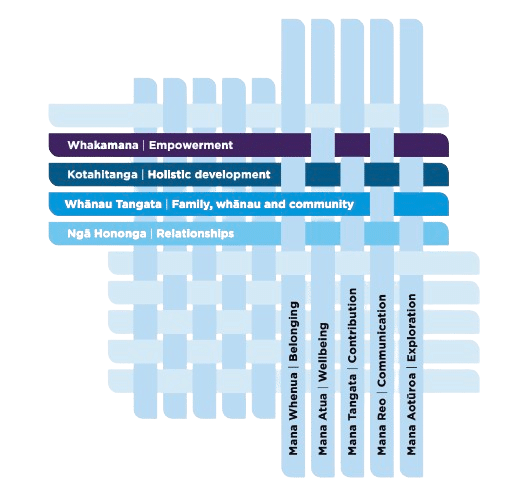Introduction
As humans we love to sort and arrange things, and frameworks are a useful tool to allow us to do this. They help us arrange complex ideas and information into more accessible formats.
They ask us to consider the connections between things, and why we are sorting things the way that we are. They can be general or specific, and the best frameworks can be utilised in a range of ways, across a range of settings.
The context for using Te Wharīki
Te Whāriki has been designed for and applied to our pēpē | babies and tamariki | children since its inception, and yet the kaupapa of the principles and strands are universal.
There is no point at which people – or communities for that matter – grow out of a need for empowerment, or for consideration to be given to belonging. We all require holistic development to grow, and our quality of relationships deeply impact our wellbeing.
Woven across these foundational principles are the strands, which could also be understood as needs – our general wellbeing, to contribute, to belong, to communicate and to explore our worlds.
Here at NZCCSS, we know that the work we do aspires to support each of these principles and strands. And more importantly, we know that the work our member organisations are grounded in these kaupapa. We also know that having a common language, with a strong evidence base, is a useful resource for shared progress.
Te Whāriki me ngā Kaumātua | Te Whāriki and Older People
Holistic approaches allow us to consider all aspects of a person. They require us to have a good understanding of the different domains of personhood, and how they impact on wellbeing.
Holistic approaches can be applied at a personal, community or even social level, and are key to how community, health and social development is practiced in Aotearoa.
However, there is no clear or specific framework, tool or approach that is regularly applied to working with older people. There are many theories and practices that relate to specific aspects of older people’s lives. There are also many holistic models that are useful (some common examples include Whare Tapa Whā, Te Vaka, the Meihana model).
In considering the most appropriate way to frame this report, we wanted a way to ensure that we considered all aspects of a person but were also able to do so at a range of levels. We wanted to be able to share things that work in specific contexts, but also talk about community and local level initiatives. We wanted to share systems, structures and national initiatives, legislation and policy. Crucially, we wanted to be able to cross-check this information against the impact on a person.
We decided that Te Whāriki – while previously used with younger New Zealanders – would allow us a strong, evidence-based and deeply New Zealand framework to shape our report. By its nature it requires high level thinking but allows for a range of uses depending on the information. It has allowed us to group concepts, and ensure we have good coverage of all aspects relevant to our kaupapa. And it will give us a language through which to discuss what we find.
We think that Te Whāriki gives us the chance to make it clear that the health and wellbeing of our older people relies on the strength of weave. Sadly, there are many gaps in the weave that urgently need strengthening. However, there are also many areas that could create healthy tension and deeper strength, as well as achieve better outcomes for our kaumātua across the motu.
As such, we have chosen to use Te Whāriki as a device to help us share with you the context of older people in Aotearoa. In using Te Whāriki, we have a confidence that we are addressing all aspects relevant to and impacting on the lives of older people. We have a framework that ensures nothing is missed, and we are also able to rely on it having been widely understood and accessible to a range of audiences. We also think it would make a powerful assessment and evaluative tool but will save that kōrero for another day.
Te tautuhi i Te Whāriki | Defining Te Whāriki
Developed by the early childhood education sector over twenty years ago, Te Whāriki is highly practical, highly researched framework designed to ensure holistic practice.

- Whakamana | Empowerment – [people] will be empowered to learn and grow.
- Kotahitanga | Holistic development – [people] learn and grow in a holistic way. Their intellectual, social, cultural, physical, emotional and spiritual learning is interwoven across all their experiences.
- Whānau tangata | Family, whānau and community – [people’s] family, whānau and community are recognised as part of their… experience.
- Ngā hononga | Relationships – [people] learn through positive relationships with people, places and things.
While the five strands are:
- Mana atua – wellbeing
- Mana tangata – contribution
- Mana whenua – belonging
- Mana reo – communication
- Mana aotūroa – exploration.
(Ministry of Education, 2022).
— To find out more about Te Whāriki click HERE
